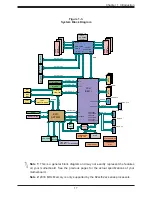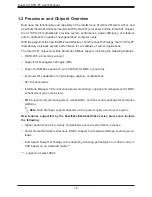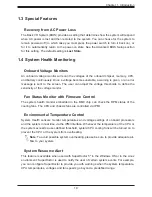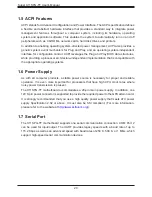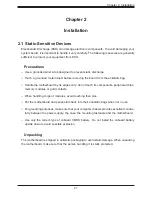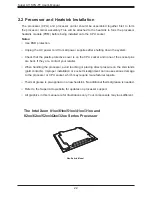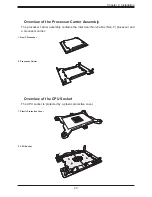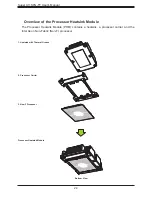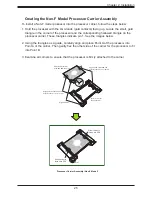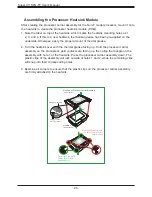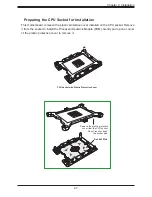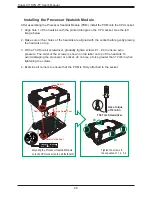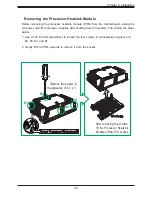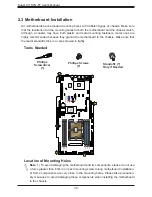
15
Chapter 1: Introduction
Note:
The table above is continued on the next page.
Motherboard Features
I/O Devices
•
Serial (COM) Port
•
One (1) front accessible serial port header (COM2)
•
SATA 3.0
•
Four (4) SATA 3.0 ports with RAID 0, 1, 5, 10 (I-SATA4~7)
•
Two (2) S-SATA 3.0 ports with RAID 0, 1, 5, 10 (S-SATA0~1)
•
Video (VGA) Port
•
One (1) VGA connection on the rear I/O panel
Peripheral Devices
•
Two (2) USB 2.0 ports on the rear I/O panel (USB0, USB1)
•
Two (2) USB 3.0 ports on the rear I/O panel (USB4/5)
•
One (1) front accessible USB 2.0 header with two (2) USB connections (USB2/3)
•
One (1) front accessible USB 3.0 header with two (2) USB connections (USB6/7)
•
One (1) USB 3.0 Type-A header (USB8)
BIOS
•
256Mb AMI BIOS
®
SPI Flash UEFI BIOS
•
ACPI 6.0, Plug and Play (PnP), PCI F/W 3.0, BIOS rescue hot-key, SPI dual/quad speed support, riser Card auto detection
support, SMBIOS 3.0 or later, real time clock (RTC) wakeup
Power Management
•
ACPI power management
•
Power button override mechanism
•
Wake-on-LAN
•
Power-on mode for AC power recovery
•
Power supply monitoring
System Health Monitoring
•
Onboard voltage monitoring for +1.8V, +3.3V, +5V, +12V, +3.3V stdby, +5V stdby, VBAT, PCH temperature, system
temperature, and memory temperature
•
5 CPU switch phase voltage regulator
•
CPU thermal trip support
•
Platform Environment Control Interface (PECI)/TSI
Fan Control
•
Fan status monitoring via IPMI connections
•
Three cooling zones
•
Multi-fan speed control support through onboard BMC
•
Eight (8) 4-pin fan headers
System Management
•
Trusted Platform Module (TPM) support
•
SuperDoctor® 5
•
Watchdog, Non-maskable Interrupt (NMI), RoHs
•
Chassis intrusion header and detection (
Note:
Please connect a cable from the Chassis Intrusion header at JD1 to the
chassis to receive an alert via IPMI)
•
Server Platform Service

















